Geared Up: Hydration Roundup
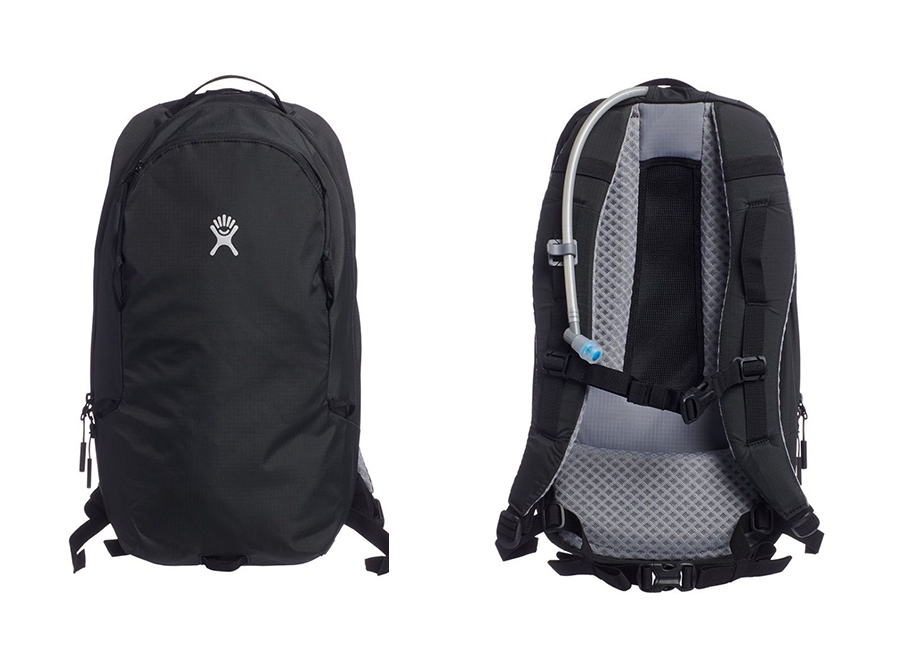
Hydro Flask Down Shift 14L Hydration Pack, $145
I first tested the prototype of this bag for hours under the blazing late-September Moab sun; I was surprised at how cool the water stayed. It wasn’t ice-cold throughout each full day of riding, but it was cool enough to still be refreshing at the top of a grueling climb. This summer, I’ve been bouncing around between Missoula, Montana, and Pittsburgh, Pennsylvania — between days in the mid-90s and days with extreme humidity — so I’ve been again appreciating the cool sip of water as I huff along on my bike.
Like many packs these days, the back panel curves away from the support panel, though it’s more pronounced on this bag than on some other brands. My back still gets hot, but the mesh panel and waffle padding design allow for impressive breathability for a 35oz pack plus the weight of water and gear.
The straps, with the same waffle padding, are very comfortable. I wish the waist strap had a bit more structural support — it’s basically a long nylon strap, though at least it has elastic loops to keep the excess from flapping in the wind. The hose stays put with a simple clip, the sternum strap can easily be clipped and unclipped with one hand, and Hydro Flask even includes a built-in whistle.
Additional details on the outside are helmet loops that are cleaner looking than a daisy chain, a rear light attachment, a reflective decal on an otherwise refreshingly inconspicuous bag, and a soft-lined front pocket for a phone or sunglasses. Rather than different designs for shorter/curvier torsos and longer, straighter ones, there is one model. Sometimes this delivers an uncomfortable pack, but I have worn this for hours without any digging in or feeling like my helmet was hitting the top of the bag.
The combination of the insulated HydraPak IsoBound reservoir, the neoprene bladder sleeve with reflective lining, and the ventilated back panel all help keep water cool, which makes this pack stand out from the, uhh, pack. The bladder also features the Plug-N-Play connect system for the hose for hassle-free fills, and the simple slide closure on top makes it very easy to clean. I do wish the hose was also insulated because on those scorcher days, I could feel the water going warm just in the time it took for me to take a drink. The pack claims to keep water cold for four-plus hours. I will agree that it prevents water from getting hot in that duration, but “cold” is used loosely. It has definitely kept water pleasurably cool on a four-hour ride when I have put ice in the bladder.
With its 14L capacity, there is plenty of room to carry a full bladder, some tools, snacks, and maybe a can of soda in a koozie (because some rides I know I deserve a treat before even leaving the house). It only carries 2L of water, which isn’t ideal for a very long ride on a sweltering day, but it’s a great way to assure a reserve of cold water while you hurriedly sip your bottles before they get warm and gross. It’s a reasonable compromise, though on the days I most need my water insulated, I typically need more than 2L. As I go on more exploratory rides where I don’t know for sure I’ll be done within a few hours, I’ve come to bring a compact water filtration system with me to filter river water as needed.
At $145, it feels a bit steep to invest in a pack that is only going to truly shine for two months of the year max in many places in the world. However, if you happen to live in a spot where it’s always hot and you can refill freely or never stray too far from a water source, the 14L Down Shift by Hydro Flask may be for you. –Carolyne Whelan
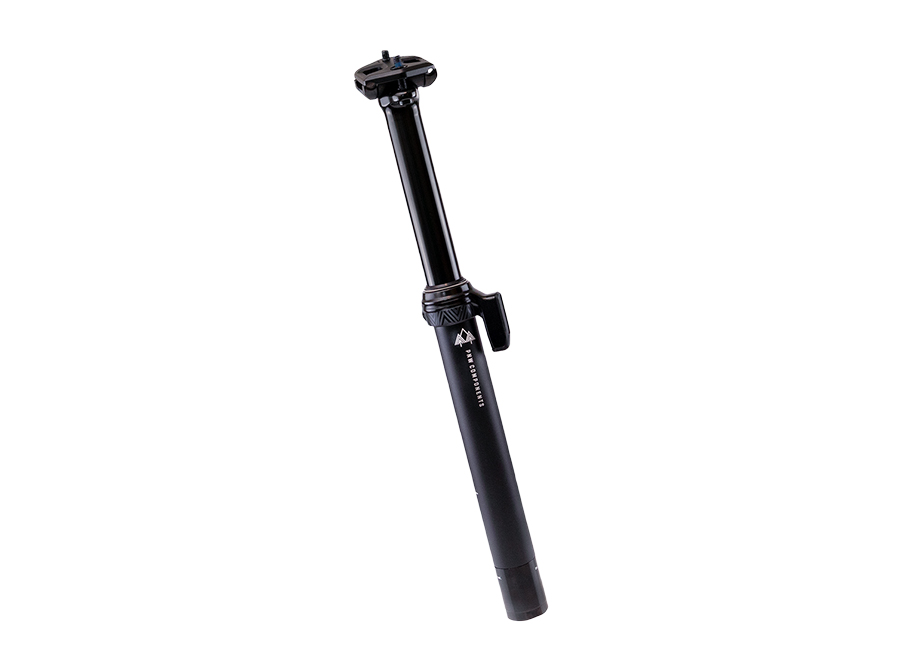
PNW Coast Suspension Dropper Post, $179
Over the past few years of gravel racing and touring, I’ve certainly found myself in many more-than-just-a-gravel-road descent situations. The large handful of rowdy descents along Adventure Cycling’s Arkansas High Country Route, for instance, could be classified as “mountain biking” — big, chunky, washed-out roads that make you hold onto your drops for dear life, praying that you don’t go over the bars. In those situations, a dropper post probably would have saved me a lot of discomfort.
With the rising use of dropper posts for more than just mountain bikes, it was a no-brainer to test PNW’s new Coast suspension dropper with up to 120mm of travel and 40mm of tunable air suspension. Having never installed a dropper myself before, I was surprised by how simple and quick the installation was. This dropper comes in three sizes (30.9mm/120mm, 31.6mm/120mm, and 27.2mm/100mm) with either external or internal cable routing. Being a woman of medium stature, I went with the 100mm and the dropper was still about an inch too tall for me — no fear, I’ve made it work for me for the past four months! I have a good idea of what height my saddle should be, so I just extend and adjust on the fly.
I’ve definitely noticed enhanced comfort thanks to the suspension soaking up bumps, and the cable-actuated dropper works flawlessly. I haven’t needed to wear a chamois on shorter rides, which has been awesome. A huge benefit to using a dropper post on a loaded bike is being able to easily lower the saddle when stopped at an intersection to put your whole foot comfortably on the ground instead of balancing a heavy bike with the tips of your toes. Additionally, you can lower the seat when mounting the bike. –Ally Mabry
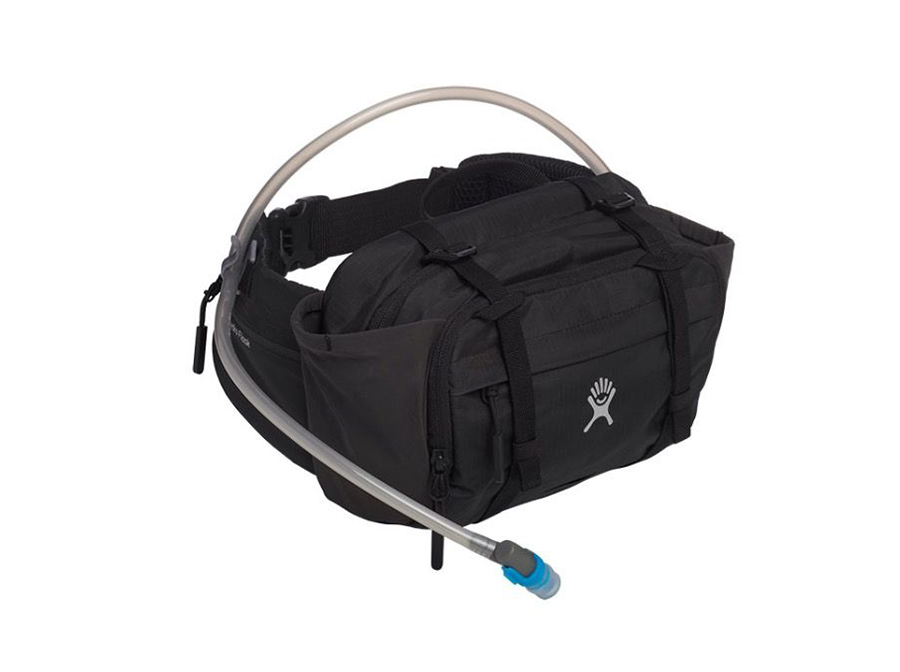
Hydro Flask Down Shift 5L Hip Pack, $100
Due to the ongoing series of “heat domes” this summer, I’ve come to rely on my stash of insulated water bottles to get outdoors without pitching over from heat stroke. But not all my bikes can fit a full-sized bottle, which is where Hydro Flask’s Down Shift hip pack comes into play. (Yes, this is a fanny pack version of the 14L Down Shift reviewed above.) It looks simple enough: the bladder pocket is lined with neoprene and reflective foil, and the 1.5L bladder itself is insulated. The Down Shift hip pack also includes zippered storage pockets for snacks and other essentials, a thickly padded waistband that proved comfortable, and a stretch pocket on either side for bottles. The tube clips to the left side of the waistband and is long enough that I can leave it in my mouth without crouching over. It’s nice being able to sip and pedal with both hands on the bar.
Hydro Flask claims four hours of cold water from their Cold Flow system. Although I didn’t perform any scientific tests, I can confirm that the Down Shift’s insulated bladder works very, very well. On more than one occasion, I filled the bladder with tap water and only half as many ice cubes as I could have fit, and I was still sipping on refreshingly cold water after two hours in the hot sun (1.5L doesn’t last me much longer than that anyway). With a full complement of ice cubes, I don’t doubt you’d have cold water even longer. The drinking hose, however, is not insulated, so it helps to blow into it after each sip lest the water left in the tube bake in the heat.
With a full bladder and my phone, keys, and a snack, the Down Shift felt stable enough for riding singletrack, though it isn’t the most stable hip pack I’ve used. I found myself adjusting the waistband fairly often. The external bottle pouches double the pack’s water capacity but would also make it pretty heavy. You could always leave the bladder at home and just use the bottle pockets, which makes the Down Shift a pretty versatile hip pack. At $100, the Down Shift 5L isn’t cheap, but considering how well it insulates, I’d consider it a fair price. –Dan Meyer
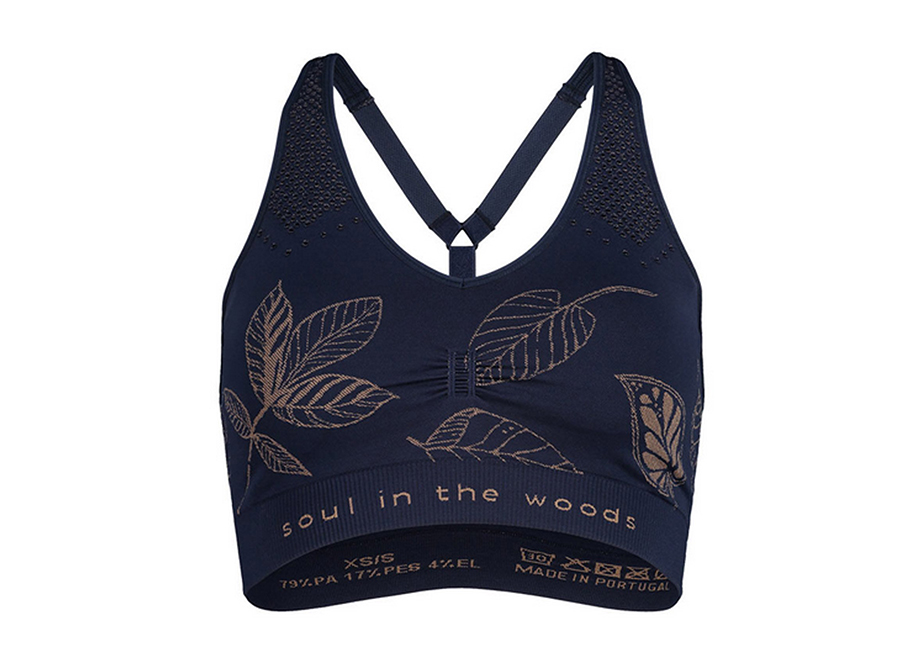
Maloja SteinkrautM., $75
For many people with breasts, the discomfort when cycling doesn’t necessarily come from too much movement (compared to running or boxing), but from wires that dig in, heat and sweat that becomes trapped, and skin that gets pinched or chafed. I love a good lightweight, medium-light support bra that offers enough support to protect during a sprint or on rugged terrain but is still breathable and offers enough movement that I don’t feel restricted or stifled. The SteinkrautM. offers all-over mobility with four-way stretch while still maintaining breathability. I like that it has a gathered center to prevent the “uniboob” effect that gets sweaty and overheated much more quickly, and the underbust cuff is surprisingly soft for being ribbed and stays in place without folding over or digging in. The fabric has different knit structures at strategic spots to further help with ventilation, which is much appreciated during this very hot summer.
Using what they call a “freeknit” technology, there are minimal seams, again reducing risk of friction or digging in. Rather than utilizing tags, the size and wash instructions are printed into the fabric itself, again reducing chafing spots. While the shoulder straps aren’t adjustable, the back strap they connect to via an o-ring for a racer-back fit is adjustable. This means there is less ability to get a proper fit if you are bigger on one side than the other, or have a shoulder injury, but it also means less opportunity for adjustments to slip out from their desired spot. The design is cute with a leaf motif and “soul in the woods” on the undercuff, a feature to which I ordinarily wouldn’t pay too much mind but on these 100-degree days, something I feel cute and strong in becomes a big help for morale as I take off my jersey to dip it in the river to cool off. –CW
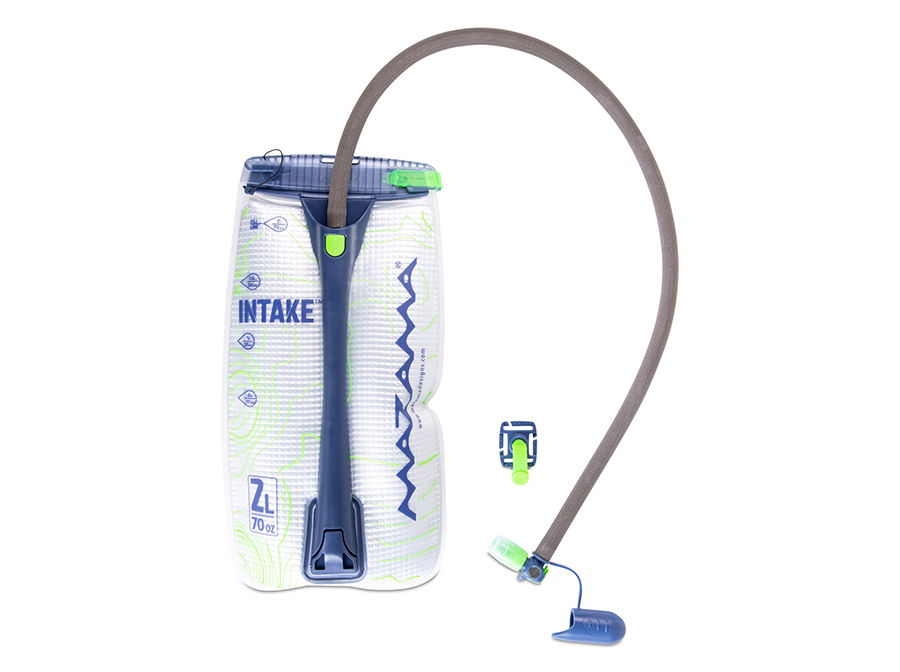
Mazama INTAKE 2L Insulated Reservoir, $40
The Mazama INTAKE is designed as a universal bladder to fit in whatever pack you may have. I used it in my trusty ACRE Hauser pack, in which it fit with room to spare. The first thing I noticed about the Mazama was its unusual design: it features a plastic “spine” running vertically along the outside. I thought it was a handle (it is), but it’s also part of the hose. It’s a nice little touch because it means the detachable hose is significantly shorter than most and attaches near the top of the bladder as opposed to the bottom, which is handy. Just as handy is the Mazama’s nozzle — it has three settings (closed, open, and free-flow), a cap (great for Salt Lake City’s dust season), and a neat little magnet that mates to a clip you can attach to a strap. The magnet is strong enough that you can secure the nozzle without looking, but not so strong that it can withstand rough singletrack. Not a big deal, just something to take note of. Also worth noting is that the hose seems to fit best when mounted cross-body.
With plenty of ice cubes, the Mazama INTAKE served up cold water well into two-hour rides in the hot sun. Interestingly, the hose has an insulated sleeve, but any water left in the hose would quickly heat up regardless. I blew into the nozzle after each sip to avoid drinking the dreaded hot hose water. With a flip-open top, like the Hydro Flask bladders, the Mazama was easy to fill and close back up again, if not just a tad fiddlier than Hydro Flask. For me, a 2L bladder is on the small side for a full backpack, but that’s often the case with insulated bladders. An hour or two into a ride, would you rather have ice-cold water, albeit less of it, or a larger quantity of tepid water? I know what I’d rather have. –DM
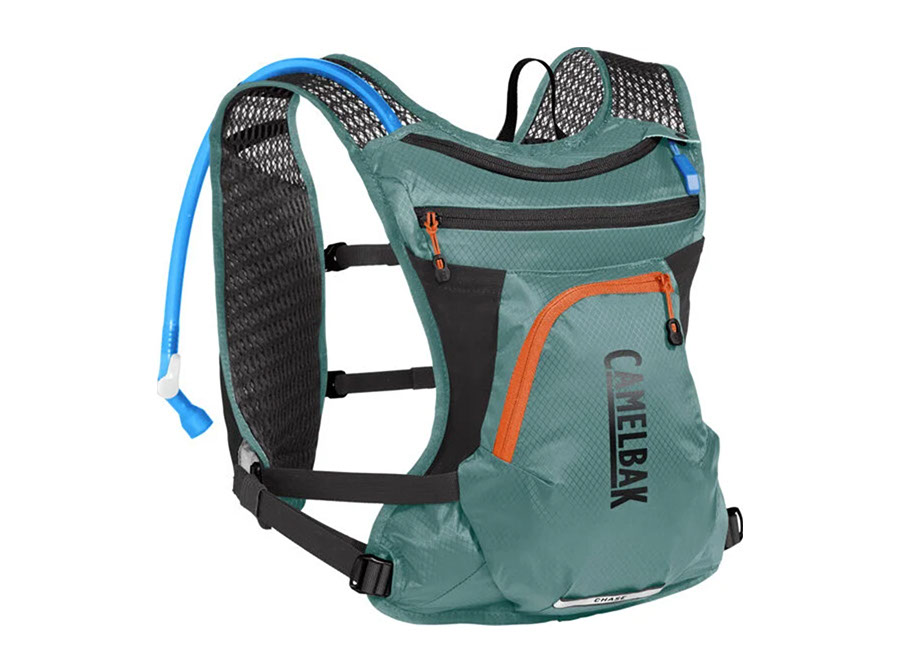
CamelBak Chase Bike Vest, $100
Unlike the other hydration systems reviewed here, CamelBak’s Chase Vest isn’t insulated. But if you’re not concerned about ice-cold water and are instead looking for a lightweight, comfortable, and stable way to carry some extra liquid on your back, read on. CamelBak calls it a vest, but it’s more like a feather-light backpack that rides higher than a normal pack. The back panel and straps are all mesh to keep it breathable, and for such a little thing, pockets abound: a zippered one on the left strap that’s perfect for a phone, a couple of stretchy ones on the right strap for quick access to snacks, a small one on the back for keys and the like, and a larger main compartment for a light jacket. The included 1.5L bladder slips into its own pocket at the top. Unlike most hydration packs, there is no waist belt — instead, there are two sternum straps.
What I noticed most about the Chase Vest was how little I noticed it. For the most part, it just disappeared into the background. The weight of the 1.5L of water on my back seemed invisible, the nozzle was easy to access and stow, and I really liked having the phone pocket right there on my chest. No need to shimmy the pack off and fish around in a pocket to take a picture or answer a text. In the majority of riding situations, I found the Chase Vest to be very stable and comfortable, but it did bounce around during rough singletrack descents. It wasn’t enough to keep me from using it, but it’s worth mentioning.
If you’re looking to carry a little extra water on your rides, the Chase Bike Vest just might be the most comfortable way to do it. –DM

